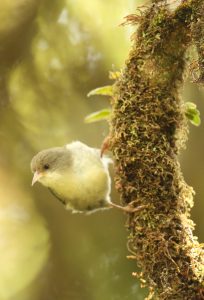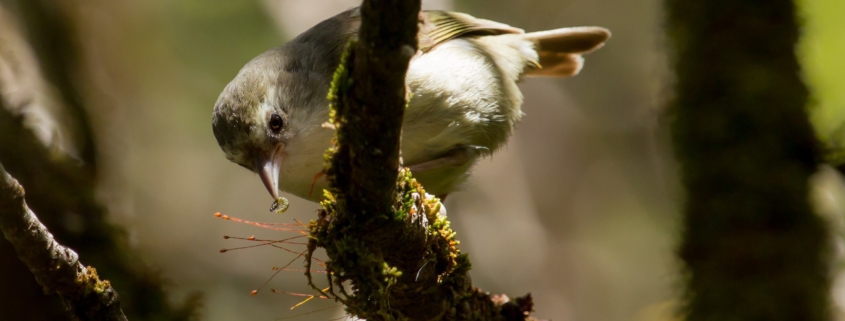Raise your leo: Kauaʻi Mosquito Suppression
About the project

ʻAkikiki, and endangered Kauaʻi forest bird. PC: Justin Hite, Kauaʻi Forest Bird Recovery Project
Hawaiʻi’s forest birds are facing an extinction crisis. Avian malaria transmitted by non-native mosquitoes has decimated native forest bird populations. Of Kauaʻi’s 16 native honeycreepers, 10 have gone extinct. Of the remaining birds, the ʻakikiki is predicted to go extinct by 2025 and the ʻakekeʻe by 2034 (Paxton et al. 2022; see EA for full citation).
The Department of Land and Natural Resources (DLNR) and U.S. Fish and Wildlife Service (USFWS) propose using the Incompatible Insect Technique (IIT) to reduce mosquito populations within approximately 59,204 acres of forest reserves, state parks, and private lands in the Kōkeʻe and Alakaʻi areas of Kauaʻi. This project is intended to suppress mosquitoes known to transmit diseases to native forest birds in critical higher-elevation native forest habitat.
The USFWS and DLNR are preparing a joint environmental assessment (EA) to address the impacts of the release of male mosquitoes with incompatible Wolbachia in the Kōkeʻe and Alakaʻi Wilderness areas. This EA provides background information concerning IIT and outlines the proposed action, potential impacts, and strategies to avoid and minimize potential negative effects of the proposed release of incompatible male mosquitoes within the project area on Kauaʻi. The EA is available below.
Both DLNR and USFWS are members of Birds Not Mosquitoes, a multi-agency partnership urgently working to protect the native Hawaiian honeycreepers from extinction. In addition to the EA below, users may want to review the educational information on this partnership site, including a description of how IIT functions, and answers to Frequently Asked Questions about protecting Hawaiʻi’s birds through mosquito control. Users interested in native birds can explore our native bird profile pages.
Read the draft Environmental Assessment
The draft environmental assessment will be available for public comment for 31 days, June 23 to July 24, 2023. The document is available at the following link:
Hard copies are available for review at the Hawaiʻi Document Center and the Waimea, Līhuʻe and Princeville branches of the Hawaiʻi State Public Library.
Raise your leo and submit a comment
In order to be considered, comments must be received on or before July 24, 2023. All comments and materials received will become part of the public record associated with this action. Comments can be submitted in multiple ways:
-
- Online via the comment form here.
- Via email to mosquitocontrol@hawaii.gov
- Via mail, postmarked by July 24, 2023, to: Department of Land and Natural Resources, Division of Forestry and Wildlife, Attn: Mosquito Control Project, 1151 Punchbowl Street, Room 325, Honolulu, HI 96813
- In writing at a public meeting on July 11, 2023, from 5:00 p.m. to 7:00 p.m., at the Kauaʻi Philippine Cultural Center, 4475f Nuhou St, Lihue, HI 96766

 Robby Kohley
Robby Kohley

